#Hellas Planitia
Text
Where to Settle on Mars
The story behind “Red Gold” needed the settlers to make a totally unexpected discovery, so I used my imagination. I eventually got an agent, the book went to an editor of a major publisher, but the editor died and the replacement cleared his desk, and apparently informed the agent that my story was “too far-fetched”. So, what was far-fetched? Colonization of Mars? Someone trying out a fraud to…
View On WordPress
#elements in rocky planets#Hellas Planitia#Martian rivers#origin of ores#original Martian atmosphere#rocky planet composition#salts
0 notes
Text
An incredibly detailed image of Mars captured by ESA’s Mars Express spacecraft — from the north polar ice cap to the cloud covered Hellas Planitia in the south, the largest impact crater on Mars.
📸: ESA / DLR / FU Berlin
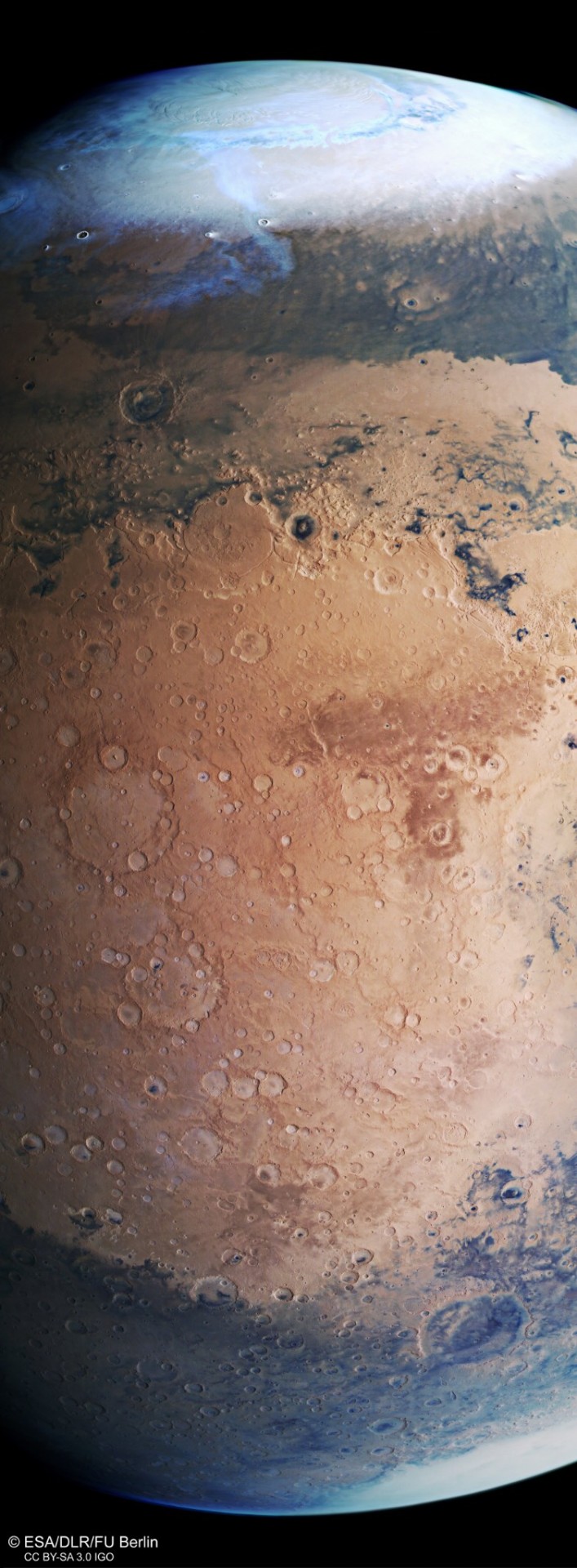
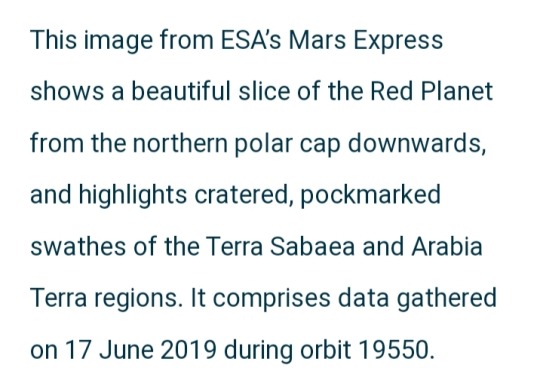


#Mars#Mars Express#European Space Agency#ESA#High Resolution Stereo Camera#red planet#planet#astronomy#space#Hellas Planitia#crater#space exploration#spacecraft
1 note
·
View note
Text
Terra Sabaea and Arabia Terra – ESA Mars Express

One of my all-time favourite images of Mars is this enhanced colour image captured by ESA's Mars Express orbiter on 17 June 2019. It shows a beautiful slice of the Red Planet stretching from the north polar cap to the northern rim of Hellas Planitia, highlighting the crater surface of Terra Sabaea and Arabia Terra. The original image has a resolution of about 1 km/pixel.
To the north, two craters stand out to me: Lyot (a complex crater in Vastitas Borealis) and Moreux (a smaller but visually darker crater in a geologically complex region of Arabia Terra). Near the centre of frame are a pair of large but shallow craters: Cassini and Tikhonravov. To the south lies Huygens, the largest crater on Mars with a well defined rim.
About the mission
Mars Express was launched from the Baikonur Cosmodrome on 2 June 2003 and entered into orbit around Mars in record time on 25 December 2003. It's the second longest lasting Mars orbiter in history after NASA's 2001 Mars Odyssey orbiter.
Due to its flexibility and importance in the study of Mars, the mission has been repeatedly extended to as far out as 2026, with a further provisional extension to 2028 likely. It's hard to believe that this was the same orbiter that deployed the failed Beagle 2 lander to the Martian surface almost 20 years ago.

16 notes
·
View notes
Photo
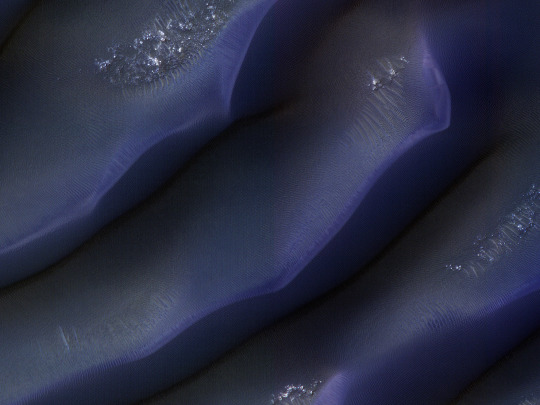
HiPOD 15 Dec 2022: Dunes in Hellas
This beautiful dune field is located along the western margin of Hellas Planitia, the floor of a giant depression in the Southern Hemisphere of Mars.
Scientists on the HiRISE team take multiple pictures of the same dune fields on the Red Planet to see if they can detect subtle changes that would indicate if the dunes are moving. Some Martian dune fields do shift and move under the present day environmental conditions, but at a rate that is typically much slower than dunes move on Earth.
ID: ESP_075654_1385
date: 16 September 2022
altitude: 257 km
NASA/JPL-Caltech/UArizona
58 notes
·
View notes
Text

The dune fields of Hellas Planitia on Mars
29 notes
·
View notes
Text
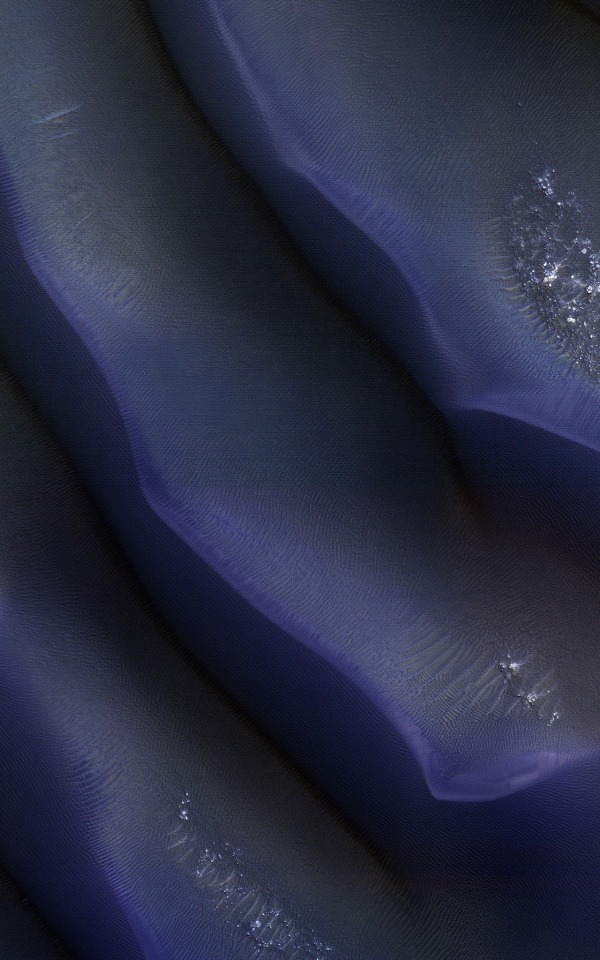
Waves? Fabric? Flower petals? Nope! Another false-color image from NASA HiRISE of dunes on Mars. This dune field is located along the western area of Hellas Planitia in the southern hemisphere.
“Scientists on the HiRISE team take multiple pictures of the same dune fields on the Red Planet to see if they can detect subtle changes that would indicate if the dunes are moving. Some Martian dune fields do shift and move under the present day environmental conditions, but at a rate that is typically much slower than dunes move on Earth.” - NASA
You can find this image in the JPL Photojournal
#nasa#space#spaceflight#engineering#science#spacecraft#technology#space exploration#aerospace#mars#hirise#nasa hirise#nasa mars#satellite#martian#sand#space photography#astrophotography
19 notes
·
View notes
Note
Happy astromonday!!
If Venus is Earth's evil twin, Mars is Earth's... similar smaller cousin maybe? Anyway this new mini series is on Mars!! Here is sunset from his Gusev crater, look how small the sun looks compared to how we know it!!
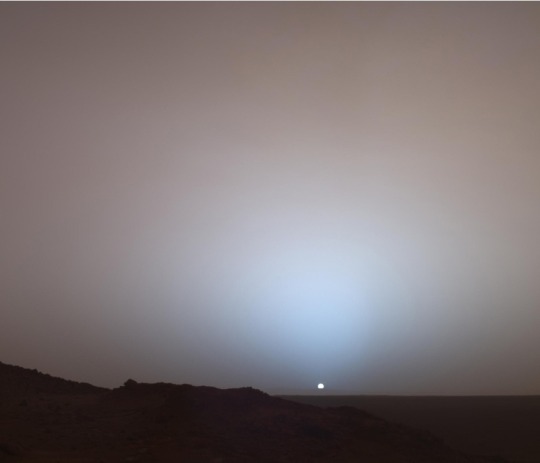
Mars is the fourth planet from the Sun at 142 million miles away (228 million km). He is the second-smallest planet (after Mercury), and takes 686 days to orbit the Sun - just under two Earth years. While Mars is much smaller than Earth - only about half the size - in some ways he is quite similar!! His day (known as sol) is 24.6 hours, only slightly longer than ours. And his temperature average is -63°C (-81°F) but in summertime is up to 18°C (70°F)!!
Known for his distinctive red colour in the sky, the ancient Egyptians named it "red one" and he is formally named after the Roman god of war. The red appearance is because of iron, making up the dust on his surface. This was heated and erupted from Mars' core by volcanic activity millions of years ago, which reacted to oxygen in the atmosphere, causing it to rust. Some of the dust is blown in dust storms in his atmosphere, so we see him as red from here.
He also has some of the most interesting geographical features in the solar system. He has polar ice caps like ours, with liquid water. Valles Marineris is a canyon up to 7km deep; originally thought to be a tectonic rift it is now thought to be a lava channel. Hellas Planitia is an impact crater deeper than the height of Everest (8.8km). And speaking of Everest, the extinct Olympus Mons at 25km high is the largest volcano in the solar system!!
I will go into more on human observations of Mars next week, for now have a fantastic day!! 🪐
Happy astromonday juno!!💖
That picture is wild IT LOOKS SO TINY OMG
Also I live for the fact that this mfker has the same temperature as literally any country in northern Europe dfhkhffgn we should consider moving there in summer (instead of lerwick, although that still sounds lovely around heat stroke season)
2 notes
·
View notes
Note
Happy astromonday!!
If Venus is Earth's evil twin, Mars is Earth's... similar smaller cousin maybe? Anyway this new mini series is on Mars!! Here is sunset from his Gusev crater, look how small the sun looks compared to how we know it!!
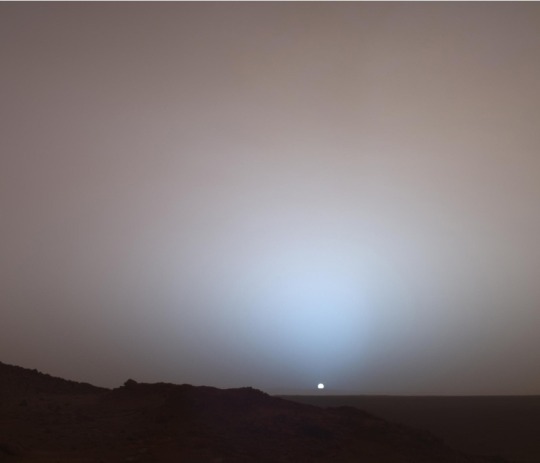
Mars is the fourth planet from the Sun at 142 million miles away (228 million km). He is the second-smallest planet (after Mercury), and takes 686 days to orbit the Sun - just under two Earth years. While Mars is much smaller than Earth - only about half the size - in some ways he is quite similar!! His day (known as sol) is 24.6 hours, only slightly longer than ours. And his temperature average is -63°C (-81°F) but in summertime is up to 18°C (70°F)!!
Known for his distinctive red colour in the sky, the ancient Egyptians named it "red one" and he is formally named after the Roman god of war. The red appearance is because of iron, making up the dust on his surface. This was heated and erupted from Mars' core by volcanic activity millions of years ago, which reacted to oxygen in the atmosphere, causing it to rust. Some of the dust is blown in dust storms in his atmosphere, so we see him as red from here.
He also has some of the most interesting geographical features in the solar system. He has polar ice caps like ours, with liquid water. Valles Marineris is a canyon up to 7km deep; originally thought to be a tectonic rift it is now thought to be a lava channel. Hellas Planitia is an impact crater deeper than the height of Everest (8.8km). And speaking of Everest, the extinct Olympus Mons at 25km high is the largest volcano in the solar system!!
I will go into more on human observations of Mars next week, for now have a fantastic day!! 🪐
Beautiful picture!! I am quite surprised to learn that there are ice caps on Mars, mainly because it’s so red! Though like you said, I guess he only appears red to us because of the dust.
Very excited for next week!
2 notes
·
View notes
Note
Happy astromonday!!
If Venus is Earth's evil twin, Mars is Earth's... similar smaller cousin maybe? Anyway this new mini series is on Mars!! Here is sunset from his Gusev crater, look how small the sun looks compared to how we know it!!
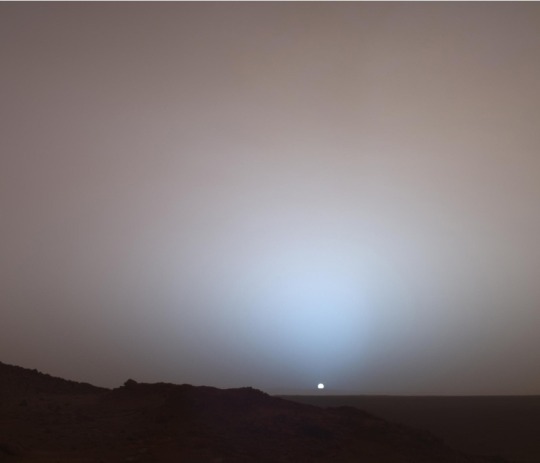
Mars is the fourth planet from the Sun at 142 million miles away (228 million km). He is the second-smallest planet (after Mercury), and takes 686 days to orbit the Sun - just under two Earth years. While Mars is much smaller than Earth - only about half the size - in some ways he is quite similar!! His day (known as sol) is 24.6 hours, only slightly longer than ours. And his temperature average is -63°C (-81°F) but in summertime is up to 18°C (70°F)!!
Known for his distinctive red colour in the sky, the ancient Egyptians named it "red one" and he is formally named after the Roman god of war. The red appearance is because of iron, making up the dust on his surface. This was heated and erupted from Mars' core by volcanic activity millions of years ago, which reacted to oxygen in the atmosphere, causing it to rust. Some of the dust is blown in dust storms in his atmosphere, so we see him as red from here.
He also has some of the most interesting geographical features in the solar system. He has polar ice caps like ours, with liquid water. Valles Marineris is a canyon up to 7km deep; originally thought to be a tectonic rift it is now thought to be a lava channel. Hellas Planitia is an impact crater deeper than the height of Everest (8.8km). And speaking of Everest, the extinct Olympus Mons at 25km high is the largest volcano in the solar system!!
I will go into more on human observations of Mars next week, for now have a fantastic day!! 🪐
This is awesome! Mars is so cool, I think I’ve always liked it because it’s red and also the Roman equivalent of Ares (I love Greek mythology).
Hope you have a great day!!
1 note
·
View note
Text
ghirigori in Hellas Planitia
Con un diametro di circa 2.200 chilometri, Hellas Planitia è il più grande bacino d’impatto visibile del Sistema Solare e ospita le quote più basse della superficie di Marte, oltre a una varietà di paesaggi. Questa immagine copre una piccola porzione centrale del bacino e mostra un campo di dune con molte scie di diavoli di polvere.
Al centro, si notano quelli che sembrano essere dei “graffi”…

View On WordPress
0 notes
Text
martian hangover
MATIAN HANGOVER
#poem #poetry
#mars #scfi
we were supposed to have landed
in the utopian basin
instead found ourselves in hellas planitia
yeah it was a bit warmer there
but the space bar was out of this world
that is until they closed it down for good
we were told about a mass migration
heading north to arabia terra
just outside the cassini crater
of course the winds were headed
in the wrong direction
which is exactly why we…
View On WordPress
0 notes
Note
worldbuilding asks - 3, 6, 7
thank you!!! 🥰
3. What’s a rule or social norm that is widely followed in theory, but in practice everyone knows it’s not a big deal and breaks it all the time?
Talking about Earth 😏 There are a few reasons why it is a norm:
homesickness
earth is holding mars colony by the throat and doesn't want to hear its colonists complaining about earth's actions
But of course no one cares and it's a popular coffee break topic (when bosses aren't around).
6. What is a common way to subtly insult someone in your world, without crossing into overt rudeness? Gifting an item with negative connotations? Addressing them more familiarly or formally than normal? Backhanded compliments?
In some groups, adressing familiarly would sound like an insult (especially during work hours) bc they're all so "formal" there. In some groups it's the other way. Also backhanded compliments are definitely a thing.
Related to the groups btw they love insulting each other based on the group but they're so used to it they just. simply don't care. Professions can also be used as an insult. They love fights between industries there.
7. If you pulled a random average Joe off the streets of your world and asked them to draw a house, what would they draw? (Shape, roof style, position and number of windows, etc.)
Depends on the area! I haven't figured out where all of the groups would live but basically
one of them lives in a lava tube. They were actually pretty fast at "making it home" (by using robots) and created a small idylic town there. For a random average Joe there a home would be a two-store house with a garden, and the colors can be different.
Another group created a dome city that partially is inside a mountain. They have 3-6 store apartment buildings with round windows (for the aesthetic). Citizens would either draw that, or their apartment. The apartments are somewhat small, max. two rooms + a kitchen and a bathroom etc. They do come with own washing machines though! (bc just imagine the amount of dust sjdjdjfjfjk)
Also, about the dome: yes Mars is terraformed and most of the dangerous things that are a problem rn are partly dealt with. They made the dome for fun (and to act like they're v safe and sound).
One is at the Hellas Planitia bc they need plain ground to test their tech. Houses there are terraced houses with solar panels and large windows.
Two of them are near the pole (nor sure which one yet). One of the groups has five small "skyscrapers" with shops, offices, laboratories, other services and apartments. If you asked its citizen to draw you a house, they'd definitely draw the apartment bc no one sees the building itself as a home.
The other one has a small area with dorm-like building. Everyone has a room and a bathroom, but the kitchen is for everyone.
#can you tell they all want mars to be its own thing BUT they can't work together to form a simple idea of what to do#asks#🔭 cynosure
1 note
·
View note
Text
Un massif riche en olivine dans le nord-est de Hellas Planitia
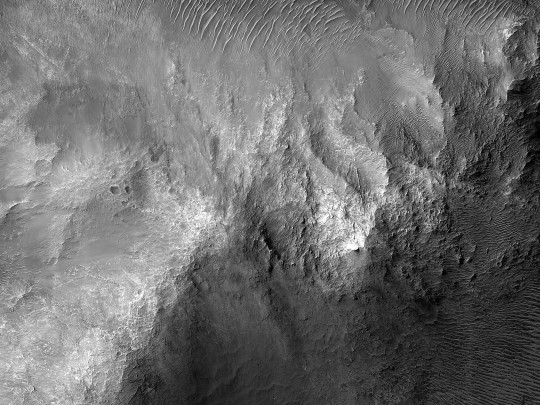
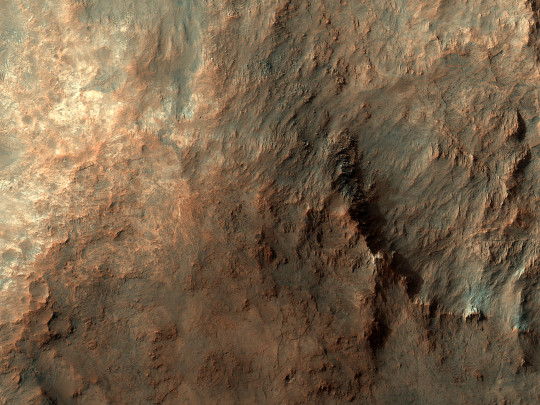
Cette observation vise un terrain rubané situé dans un massif riche en olivine dans le bassin de Hellas. Les massifs riches en olivine ont été interprétés comme des blocs d'éjectas excavés de la croûte inférieure/du manteau supérieur par l'impact. Cette observation aidera à étudier les matériaux de la croûte profonde ou du manteau qui ne sont pas autrement exposés à la surface. L'imagerie haute résolution du massif sera utile pour évaluer si ces caractéristiques ont été mises en place avant ou après l'impact Hellas.
NASA/JPL/UArizona
0 notes
Note
Happy astromonday!!
If Venus is Earth's evil twin, Mars is Earth's... similar smaller cousin maybe? Anyway this new mini series is on Mars!! Here is sunset from his Gusev crater, look how small the sun looks compared to how we know it!!
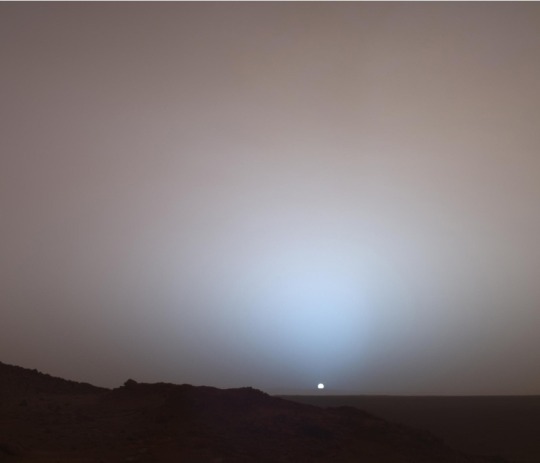
Mars is the fourth planet from the Sun at 142 million miles away (228 million km). He is the second-smallest planet (after Mercury), and takes 686 days to orbit the Sun - just under two Earth years. While Mars is much smaller than Earth - only about half the size - in some ways he is quite similar!! His day (known as sol) is 24.6 hours, only slightly longer than ours. And his temperature average is -63°C (-81°F) but in summertime is up to 18°C (70°F)!!
Known for his distinctive red colour in the sky, the ancient Egyptians named it "red one" and he is formally named after the Roman god of war. The red appearance is because of iron, making up the dust on his surface. This was heated and erupted from Mars' core by volcanic activity millions of years ago, which reacted to oxygen in the atmosphere, causing it to rust. Some of the dust is blown in dust storms in his atmosphere, so we see him as red from here.
He also has some of the most interesting geographical features in the solar system. He has polar ice caps like ours, with liquid water. Valles Marineris is a canyon up to 7km deep; originally thought to be a tectonic rift it is now thought to be a lava channel. Hellas Planitia is an impact crater deeper than the height of Everest (8.8km). And speaking of Everest, the extinct Olympus Mons at 25km high is the largest volcano in the solar system!!
I will go into more on human observations of Mars next week, for now have a fantastic day!! 🪐
Hello! I would have always thought Mars was the evil twin because it was all red and stuff, but it is what it is.
1 note
·
View note
Photo

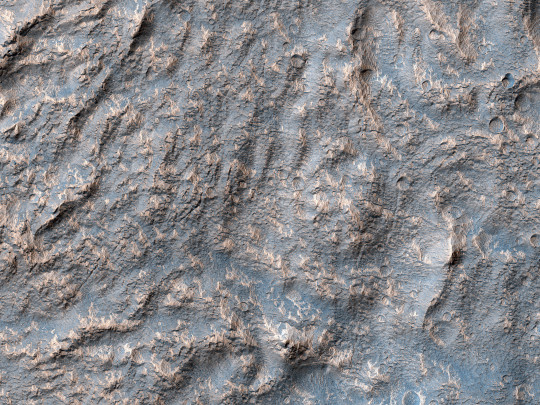
HiPOD 13 Feb 2023: Channels near Reull Vallis
The objective of this observation is to examine several small channels that seem to be entering a low area. This may be evidence that the ground was quite water-rich. Reull Vallis starts in Promethei Terra and empties into Hellas Planitia and is 1,051 kilometers (653 miles) long. Reull is the Gaelic word for “planet.”
ID: ESP_076245_1425
date: 1 November 2022
altitude: 250 km
NASA/JPL-Caltech/UArizona
25 notes
·
View notes
Text
Rotation-3
I think I got the recorder working properly FINALLY.....
I've been asked to keep a catalog of my time here on tape to be sent back to base to keepa record of my supply levels, samplings, onsight and distance disturbances, and my deteriorating mentalllleehhhgh
Sooo000ooO0 du day DAy 3 of the Mars experiment currently everything is at normal levels, The M.O.X.I.E. machine is working well, and finally, food storages are at ummm lemme check.
?/??///
Food storages are at roughly 99.861%
Current research on the geode is going well, I've focused a majority of the work hours on studying it.
I've done more prolonged X-rays on the sample and it appears the blots might be moving, with the movements to be far from random and maybe even intelligent.
Further research is needed.
You may be wondering why I may do this when I can be spending time doing other things such as bingeing futurama, and the answer is I have no clue. FUDGE OFF MATE, It's a cool rock ok!!
Although, Certain confusion around the sample may also explain my fascination with it
As the rock has a certain smoothness very uncommon with others of its kind.
As well as geodes do not appear to be very common at all upon mars.
The Auto Quarry Site in which it had been located was not too far from the Hellas Planitia site, this may also provide an explanation for the abnormalities of the sample.
All science aside I appear to have a certain magnetic attraction to it.
Further study is to be done.
Anyways have a fun day I know I DID. Current mental state, a solid nine out of eleven.
Jamie Gomez Signing off
1 note
·
View note